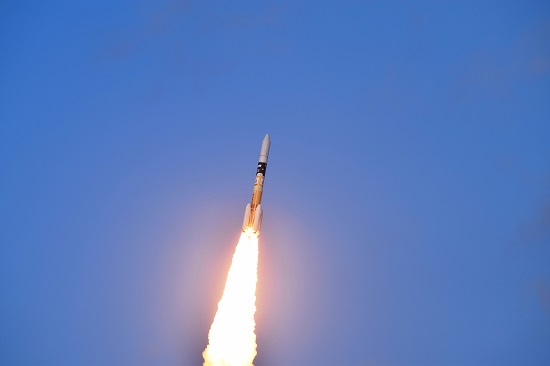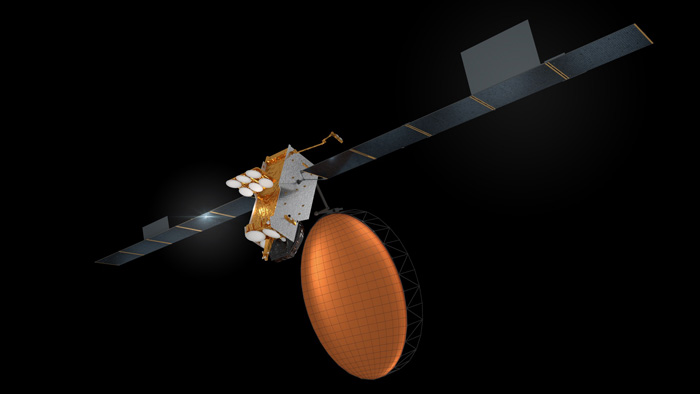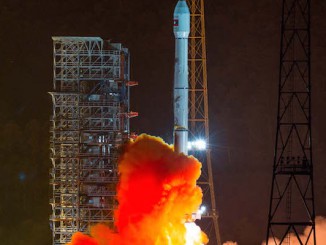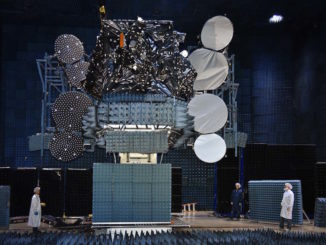
Inmarsat has selected Mitsubishi Heavy Industries to launch the first of two planned sixth-generation communications satellites on an H-2A rocket in 2020, giving the Japanese launcher its second commercial win in the global market to loft large geostationary telecom craft.
The Inmarsat 6 F1 satellite will launch aboard an H-2A rocket from Tanegashima Space Center, Inmarsat and MHI announced last week.
“Inmarsat is delighted to select MHI and its H-2A launch vehicle for the first of our sixth generation satellites,” said Rupert Pearce, CEO of Inmarsat. “Inmarsat is continually seeking to extend and diversify its ecosystem of partners, particularly in the strategically important area of launch providers. We believe that MHI and its H-2A launch vehicle offers a world-class service.”
Recent Inmarsat satellites have launched on Proton, Falcon 9, and Ariane 5 rockets operated by International Launch Services, SpaceX and Arianespace. MHI has positioned the H-2A as a secondary player in the global launch market, and the Inmarsat 6 F1 contract gives the Japanese company its second commercial telecom launch deal after the Canadian-owned Telstar 12 Vantage satellite lifted off from Tanegashima in November 2015.
Japan’s H-2A rockets typically launch government payloads, such as navigation satellites, spy and reconnaissance craft, weather satellites and interplanetary probes.
Ko Ogasawara, a vice president at MHI and director of the company’s space systems business development department, said the H-2A rocket’s track record was the selling point for Inmarsat.
MHI is prime contractor responsible for construction of H-2A rockets, and the company is also in charge of H-2A launch operations.
“The reason why we got the launch order from Inmarsat, I think, was not, of course, the cost-competitiveness of the H-2A launch vehicle, but I think our launch record is very good — 35 consecutive successes, high reliability — and another is on-time launch,” Ogasawara said in remarks last week at Euroconsult’s World Satellite Business Week conference in Paris. “We keep our schedule, and I think they put a high value on that.”
Ogasawara told Spaceflight Now that the Inmarsat 6 F1 satellite will launch on the “204” version of the H-2A rocket, the vehicle’s most powerful configuration with four strap-on solid-fueled boosters.
“We are honored to have been selected by Inmarsat, a leader in the global mobile satellite communications industry, to provide launch services,” said Masahiro Atsumi, vice president and senior general manager for space systems at MHI, in a statement. “The decision reflects the reliability and on-time delivery of our launches, as well as our highly valued technological expertise.”

MHI has won two other international launch contracts for rideshare flights with South Korea’s Kompsat 3 Earth observation satellite launched in 2012 and the KhalifaSat imaging satellite from the United Arab Emirates set for liftoff next year. The UAE’s space agency also selected an H-2A rocket to launch its robotic Mars orbiter to the red planet on a dedicated flight in 2020.
MHI and the Japan Aerospace Exploration Agency are working on the new H3 rocket set for a debut launch in 2020. The H3 rocket is designed to be more competitive in the commercial market, with prices around $50 million, about half that of an H-2A flight.
Designers are working on several versions of the H3 with two or three hydrogen-fueled first stage engines, and zero, two or four solid rocket boosters. The heaviest model of the H3 will deliver at least 14,000 pounds — about 6.5 metric tons — to geostationary transfer orbit, the drop-off target for most large communications satellites.
The H3 will replace the H-2A and H-2B rockets in MHI’s current fleet, and officials hope to double the H-2 family’s current flight rate of around four missions per year.
“As with previous launches, MHI will work closely and attentively – in the spirit of omotenashi – with Inmarsat to prepare the specifics of the launch to ensure that expectations are met,” Atsumi said. “We hope to build a strong and lasting relationship with them, and to provide further launch services using our latest H3 rocket in future.”
“With the development of the new H3 launch vehicle, it is clear that MHI is committed to continuing innovation,” Pearce said in a press release. “These are attributes that we seek in our partners and we look forward to a long and fruitful relationship with MHI as one of our roster of launch partners.”
The Inmarsat 6 F1 satellite, built by Airbus Defense and Space, will provide L-band and Ka-band communications services. It will be the first Inmarsat spacecraft to broadcast signals in two bands, supporting the company’s business beaming connectivity to ships, airplanes and other users on-the-go.
Inmarsat signed a $600 million contract with Airbus for two Inmarsat 6-series satellites in 2015. Each spacecraft will use electric thrusters to maneuver from an egg-shaped transfer orbit into a final circular perch more than 22,000 miles (nearly 36,000 kilometers) over the equator.
The launch contract for the Inmarsat 6 F2 satellite will be determined in “due course,” Inmarsat said.
Email the author.
Follow Stephen Clark on Twitter: @StephenClark1.



